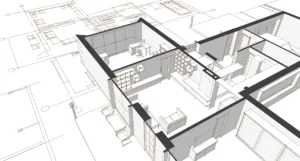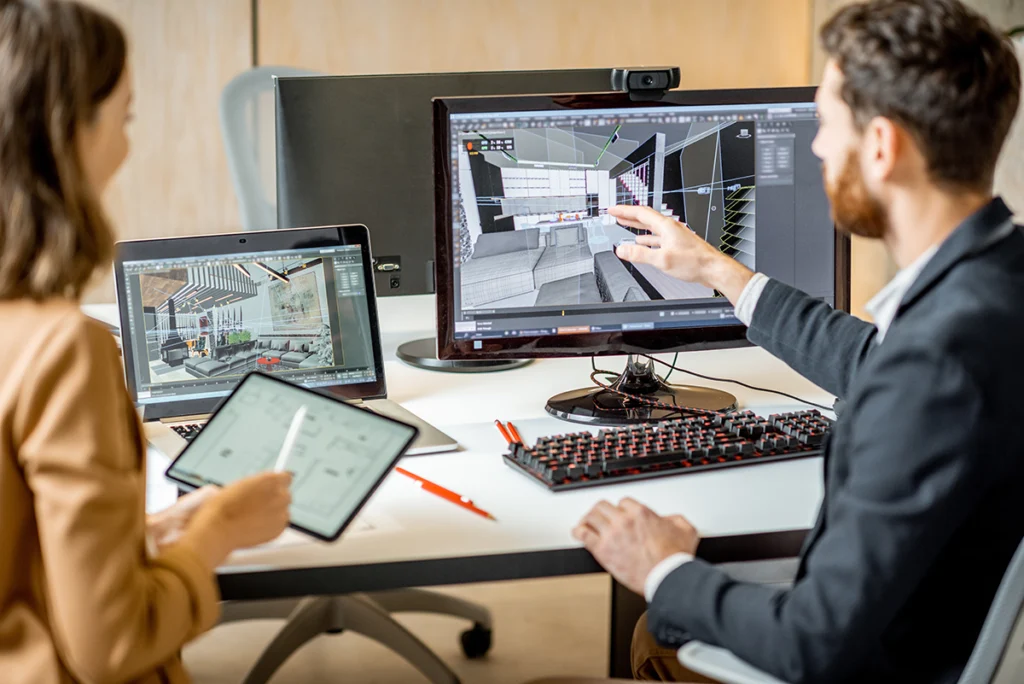Common Mistakes in Architectural Drawings
Published Date
Last Modified

- Common Mistakes in Architectural Drawings
- Common Mistakes in Architectural Drawings
- The Importance of Precision in Architectural Drawings
- Understanding Different Types of Architectural Drawings
- The Consequences of Poor Quality Architectural Drawings
- Best Practices for Annotation and Labeling
- Consistency in Drawing Conventions and Symbols
- Navigating Building Codes and Regulations in Drawings
- The Role of Software in Architectural Drawings
- The Value of Professional Drafting Services
- Common Mistakes with Revit and Other Drawing Tools
- The Importance of Collaboration and Communication
- Conclusion: Elevating Your Architectural Drawings
Common Mistakes in Architectural Drawings
Architectural drawings are the backbone of any construction project. They convey the design intent, provide detailed instructions, and guide the construction process.
However, creating accurate and effective architectural drawings is not always straightforward. It requires a deep understanding of drawing techniques, precision, and attention to detail.
Common mistakes in architectural drawings can lead to misinterpretations, construction errors, and costly revisions. These mistakes can range from incorrect measurements to overlooking building codes and regulations.
In this article, we will delve into the common mistakes made in architectural drawing techniques. We will discuss the importance of precision, the role of different types of drawings, and the consequences of poor-quality drawings.
We will also explore the role of software like Revit in creating architectural drawings and the value of professional drafting services. We aim to provide insights and best practices to help you improve your architectural drawing skills.
Whether you are an architect, a draftsman, a student, or simply interested in architectural design, this article will provide valuable insights.
So, let’s dive in and explore the common mistakes in architectural drawing techniques and how to avoid them.
The Importance of Precision in Architectural Drawings
Precision in architectural drawings cannot be overstated. Every line, detail, and annotation serves a purpose. In the world of construction, even a minor error can ripple into major setbacks.
Misjudgments in scale or proportion can result in structural imbalances. This can lead to delays, increased costs, or compromised safety. Therefore, accuracy becomes indispensable in every drawing, beginning with floor plans and extending to the final details.
Precision also ensures that the design intent is communicated without ambiguity. Clear drawings minimize misinterpretations. This bolsters collaboration among architects, contractors, and construction teams, fostering successful project outcomes.
Understanding Different Types of Architectural Drawings
Architectural drawings serve as the backbone of any construction project. They convey the architect’s vision and guide construction efforts with precision. Understanding the various types of drawings is crucial for effective design and implementation.
These drawings are typically categorized into different types:
- Floor Plans: Illustrating the layout of spaces from a bird’s-eye view.
- Sections: Vertical cuts through a building, showing levels and heights.
- Elevations: Exterior views demonstrating the façade and external design.
- Enlarged Views: Enlarged Views are created to add details like the centerline location of fixtures to Special Rooms that include wet areas such as toilets, baths, Kitchen and Staircases
- Detail Drawings: Zoomed-in views explaining intricate design elements and materials.
- Site Plans: Depicting the building’s orientation on the site and the surrounding landscape.
Each type serves its specific purpose and complements the others for a holistic view. Floor plans offer insights into spatial arrangements and room relationships. Sections reveal vertical relationships and structural systems within the building. Elevations portray the project’s aesthetic and architectural identity, focusing on the external appearance.
Detail drawings break down complex components, illustrating materials and joinery techniques. Site plans provide context, ensuring that the building harmonizes with its environment. Mastering these different types allows for accurate and comprehensive architectural representations. This mastery helps in avoiding oversights that might stem from misinterpreting design intentions.
Floor Plans: Scale and Proportion Mistakes
Floor plans are fundamental in describing spatial layouts. Errors in scale and proportion can disrupt functionality. An incorrectly scaled room might impair movement or furniture placement.
Proportions in floor plans guide space utilization. For instance, narrow corridors can hinder accessibility. Architects must ensure that the scale and proportions reflect real-world dimensions accurately.
Small mistakes in these drawings may escalate into significant issues. Consistent measurement checks and peer reviews can mitigate such risks. This ensures functional and aesthetically pleasing environments.
Sections and Elevations: Measurement and Dimension Errors
Sections and elevations reveal critical details overlooked in floor plans. Errors in measurements here can lead to severe building discrepancies. Misaligning sections can confuse construction teams, resulting in structural issues.
Accurate dimensioning in elevations affects the external facade. Any deviations might disrupt the architectural vision. Ensuring precise measurements is vital for aligning both structural and visual elements.
Regular audits of these drawings help catch early discrepancies. Teams should prioritize updating changes consistently across all drawing types. This practice maintains coherence and avoids construction conflicts.
Detail Drawings: Overlooking Material Properties
Detail drawings dive into the minutiae of construction elements. Overlooking material properties in these drawings can affect durability. Each line represents specific materials, joints, and finishes.
Choosing incorrect materials can lead to structural failures or design flaws. Understanding the properties ensures the right material is specified. It also guarantees that the design intent and structural integrity align.
Mistakes are common if the material’s behaviour under stress is not understood. Architects should study materials during the design phase. This knowledge prevents future failures and enhances the sustainability of the construction.
The Consequences of Poor Quality Architectural Drawings
Architectural drawings must be accurate and detailed. Poor-quality drawings can lead to costly errors and construction delays. These errors may result in structural deficiencies that compromise safety.
Furthermore, misinterpretations from unclear drawings can escalate project costs. Contractors might need to halt work to seek clarification, leading to financial losses and strained relationships. These inefficiencies highlight the importance of clarity in the drawing process.
Additionally, flawed drawings can cause non-compliance with building codes. This may lead to legal disputes or demand costly redesigns and reconstruction. Precision in architectural drawings is essential to ensure that projects remain on schedule and within budget.
Best Practices for Annotation and Labeling
Clear annotations and labels are crucial for comprehensible architectural drawings. They ensure that everyone involved in the project understands the design intent. Precise labels minimize misunderstandings and errors during construction.
Annotations should be legible and consistent throughout all drawings. They must use standardized symbols and terminology familiar to the industry. This approach helps in maintaining uniformity across the drawing set, making it easier for builders and clients to follow.
Additionally, using a clear hierarchy for information enhances readability. Prioritizing critical details helps stakeholders focus on the most important aspects of the design. Effective labelling not only communicates ideas efficiently but also supports seamless project execution.
Consistency in Drawing Conventions and Symbols
Consistency in architectural drawing conventions and symbols is vital. It helps create a uniform language that all stakeholders can understand. This uniformity reduces errors and enhances communication across the project team.
Adhering to industry standards is key to maintaining consistency. It involves using symbols, line types, and hatching patterns that are widely recognized. This practice ensures that those interpreting the drawings can do so without confusion.
Moreover, consistent use of conventions helps streamline revisions and updates. Changes can be communicated more efficiently when everyone uses the same visual language. Ultimately, maintaining consistency in conventions and symbols supports project accuracy and coherence.
Navigating Building Codes and Regulations in Drawings
Understanding building codes and regulations is crucial in architectural drawing. Non-compliance can lead to significant project delays and added costs. These rules ensure safety, accessibility, and legal conformity in construction.
Including all relevant codes in your drawings is essential. This means accurately representing requirements for safety, structural integrity, and sustainability. Clear communication of these details can avoid misinterpretations during the construction phase.
Staying updated with changing regulations is another challenge. Building codes can vary by region, so constant vigilance is necessary. Integrating these aspects in drawings not only meets legal standards but also enhances project credibility.
The Role of Software in Architectural Drawings
Architectural drawing software such as Autodesk Revit, has revolutionized the design process. Traditional drafting has evolved with advanced digital tools. These tools enhance accuracy and efficiency in creating complex designs.
Software applications provide features that streamline workflows. They offer templates, drawing tools, and 3D modelling capabilities. Such functionalities significantly reduce human error in design documentation.
The ability to simulate building performance is a standout feature. It allows architects to visualize and tweak designs pre-construction. This capability reduces costly modifications during the project phase.
Revit for Architectural Drawings: Advantages and Pitfalls
Revit is a prominent tool in the architectural software realm. Its comprehensive features support a range of design tasks. From creating 3D models to detailed floor plans, Revit excels.
One significant advantage is Revit’s BIM capabilities. It allows for integrated project delivery and team collaboration. Sharing updates and models among stakeholders becomes seamless.
Despite its strengths, Revit has pitfalls to consider. The software has a steep learning curve for beginners. Mastering its full potential requires time and dedication.
Additionally, over-reliance on Revit can lead to issues. Designers may overlook basic architectural principles. Understanding the tool’s limitations is vital for balanced design execution.
The Value of Professional Drafting Services
Professional drafting services play a critical role in the architecture industry. They bring a wealth of experience and expertise to any project. This ensures drawings are precise, comprehensive, and adhere to industry standards.
These services are especially beneficial for complex projects. Professionals are adept at managing intricate details that can overwhelm in-house teams. Outsourcing drafting allows architects to focus on core design activities.
Moreover, drafting services offer scalability and flexibility. As projects scale up or down, these services adapt to meet changing demands. This adaptability makes them a cost-effective solution for both small and large firms.
Common Mistakes with Revit and Other Drawing Tools
Relying too heavily on Revit and similar tools can lead to oversights. Users may depend on automated features without checking accuracy. This can result in flawed designs if not carefully managed.
Another common mistake is neglecting to customize software settings. Each project may require unique templates and tools for efficiency. Failing to adjust these can slow down productivity and lead to errors.
Lastly, insufficient training or updates on new features pose risks. Regular learning and practice are crucial in mastering drawing tools. Professionals should stay informed about software developments to maximize their capabilities.
The Importance of Collaboration and Communication
Effective collaboration is key in the drafting process. Architects often work with engineers and designers. Each must align to avoid conflicts in project details.
Open communication ensures everyone shares the same vision. Misunderstandings can lead to design flaws that are costly to fix. Regular meetings and updates minimize such risks.
Technology aids collaboration, allowing real-time updates and feedback. Cloud-based platforms make sharing easier and faster. Utilizing these tools enhances teamwork and project outcomes.
Conclusion: Elevating Your Architectural Drawings
Improving architectural drawing techniques demands continuous effort and adaptation. Being mindful of common mistakes is the first step to better drawings. By understanding and addressing these errors, architects can enhance both the quality and clarity of their work.
Embracing new technologies like Revit can further streamline the drafting process. It allows for detailed, precise, and collaborative designs. However, it is crucial to understand both its potential and its limitations.
Lastly, collaboration and effective communication are vital elements. These not only prevent mistakes but also ensure a unified vision among all stakeholders. By adopting these strategies and applying best practices, architects and draftsmen will significantly improve the effectiveness of their architectural drawings.


